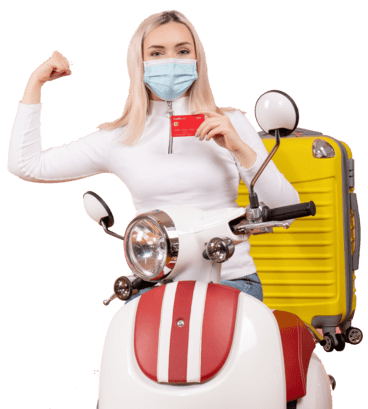Equipping oneself with the right protective gear is a fundamental aspect of motorcycle riding. Riding gear serves a dual purpose – safeguarding the rider and enhancing the riding experience.
Helmet
The Types of Helmets
There are various types of motorcycle helmets available, including full-face, open-face, flip-up, off-road, and half helmets. Full-face helmets offer the best protection, covering the entire head and face, whereas open-face and half-helmets provide less coverage but more ventilation.
Helmet Safety Standards
Motorcycle helmets should adhere to safety standards such as DOT (US Department of Transportation), ECE (Economic Commission for Europe), or Snell (Snell Memorial Foundation). These standards test aspects like field of vision, shock absorption, retention system effectiveness, and chin strap strength.
Proper Helmet Fit
A properly fitting helmet is essential for your safety and comfort. The helmet should snugly fit your head without causing discomfort. It should sit level on your head, and not tilt back, exposing your forehead. The cheek pads should touch your cheeks without pressing uncomfortably.
Jackets and Pants
Motorcycle jackets and pants offer protection against abrasions in case of a fall. They come in various materials like leather, textile, or Kevlar, and often have built-in armor at vital impact points.
Choosing the Right Material
The material of your motorcycle jacket and pants significantly influences their protective qualities and comfort. Leather, a popular choice, offers excellent abrasion resistance, while textile provides versatility with its lighter weight and weather resistance. Kevlar, a synthetic fiber, boasts superior strength and heat resistance.
Importance of Proper Fit
Just like helmets, jackets and pants should fit properly for maximum protection and comfort. They should be snug but not overly tight, allowing ease of movement while riding. Too loose, and they fail to protect you properly; too tight, and they can restrict your movements and cause discomfort.
Considerations for Weather Conditions
Choose jackets and pants that are suitable for the climate and weather conditions you’ll be riding in. For colder climates, opt for insulated gear, while in hot and humid conditions, ventilation features are key. Waterproof or water-resistant gear is a must for rainy weather.
Importance of High Visibility
Motorcycle jackets and pants often come with high-visibility colors and reflective strips. These features increase your visibility to other road users, especially in low light conditions, reducing the risk of accidents.
Gloves
Gloves protect your hands from the elements and potential injuries. They also offer better grip and control. Choose gloves that cover your hands completely and are made of durable material.
Types of Gloves
Motorcycle gloves come in a variety of styles, each serving different purposes. Gauntlet gloves cover the entire hand and wrist area, providing maximum protection. Short gloves, on the other hand, cover just the hands, offering more comfort and flexibility. Race gloves are designed for track use with the highest level of protection, while touring gloves are aimed at long-distance riders, focusing on comfort and weather protection.
Material and Construction
The construction material greatly affects a glove’s durability, comfort, and protection level. Leather gloves, known for their durability and protection, are a popular choice among riders. Textile gloves offer a lighter weight, more flexibility, and typically better weather resistance. Many gloves feature a combination of materials for an optimal balance between protection and comfort.
Fit and Comfort
Like other riding gear, gloves should fit well to provide effective protection and riding comfort. They should be snug but not tight, allowing your fingers to move freely. The gloves’ interior should feel comfortable, with no seams or tags causing irritation.
Weather Considerations
Depending on the riding conditions, different types of gloves may be required. Insulated winter gloves keep your hands warm in cold weather, while ventilated summer gloves help keep your hands cool in hot conditions. Waterproof gloves are essential for riding in rainy weather.
Safety Features
Some motorcycle gloves come with added safety features such as hard knuckle protectors for impact protection, palm sliders to reduce friction in a slide, and high-visibility colors or reflective materials for increased visibility on the road.
Boots
Motorcycle boots shield your feet and ankles while riding and provide better grip when you stop. They should be sturdy, with non-slip soles and ankle support.
Types of Motorcycle Boots
Motorcycle boots come in several styles, each offering different levels of protection and comfort. Touring boots, designed for long-distance riders, prioritize comfort and weather protection. Racing boots, on the other hand, focus on providing the highest level of protection, often with reinforced toe, heel, and shin guards. Off-road boots are sturdy and high, offering maximum coverage and protection for rough terrains.
Material and Construction
The materials used in motorcycle boots directly impact their durability, comfort, and safety level. Most motorcycle boots are made of leather or synthetic materials, which offer excellent abrasion resistance. Some boots incorporate materials like Kevlar or metal for extra protection.
Fitting and Comfort
A well-fitted motorcycle boot is crucial to rider safety and comfort. Boots should fit snugly without being too tight and allow enough room for toe movement. Additionally, they should provide ample ankle support and have comfortable insoles.
Weather Considerations
Just like other motorcycle gear, boots should be chosen considering the climate and weather conditions. For colder climates, insulated boots are a good choice, while for rainy weather, waterproof or water-resistant boots are essential. Ventilated boots are ideal for hot or humid conditions to keep the feet cool.
Safety Features
Safety features in motorcycle boots can include reinforced toe and heel boxes, ankle protectors, and non-slip soles for better grip. Some boots also have reflective materials to enhance visibility to other motorists, particularly in low-light conditions. High-rise boots provide additional shin protection, which is particularly beneficial for off-road riding.
Safety Vest
A high-visibility safety vest makes you more noticeable to other road users, especially in low-light conditions.
Safety vests, often characterized by their fluorescent colors and reflective strips, are an essential part of a rider’s gear, providing additional visibility on the road.
Material and Construction
Safety vests are usually made from lightweight, breathable materials, which make them comfortable to wear even in hot weather. The most significant feature of these vests is the high-visibility colors and reflective strips, designed to catch the attention of other road users. These strips reflect light from headlights and streetlights, making the rider more noticeable in low light or at night.
Fit and Comfort
A motorcycle safety vest should fit comfortably over your riding jacket. It should be loose enough to not restrict movement but not so loose that it flaps in the wind while riding. Many vests come with adjustable straps for a better fit.
Weather Considerations
Most safety vests are designed to be worn in all weather conditions. They are typically waterproof or water-resistant, providing protection in rainy weather. For hot and humid conditions, look for vests with ventilation features to aid in cooling.
Additional Features
Some safety vests may also include extra features for rider’s convenience, such as pockets for storing small items or integrated hydration systems. Some vests are also equipped with padding or armor for additional protection, though these are not a substitute for a good quality riding jacket.
Remember, a safety vest is not a standalone safety solution but serves to enhance the protective features of your other gear.
In conclusion, the significance of proper motorcycle gear cannot be overstated. It serves an essential role in providing protection, enhancing visibility, and ensuring comfort during rides. The key to choosing the right gear lies in understanding its features and selecting the type that best suits your riding style, weather conditions, and personal preferences. Remember, each gear type – be it gloves, boots, or a safety vest – has its own unique function and contributes to your overall safety and comfort. Equipping yourself with the right gear not only elevates your riding experience but also adds an extra layer of protection, ultimately making your journey on two wheels safer and more enjoyable.


